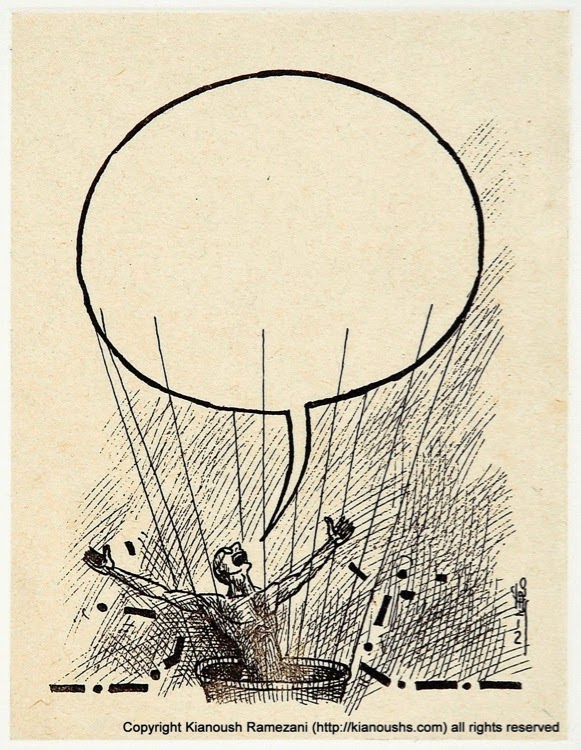Action versus Reaction
"One thing I don't like about professional cartooning is to follow the news, to wait for the crisis to react! A cartoonist must observe and "act", not just "react". A cartoonist is supposed to be an Activist in the society, not just the illustrator of the world's stupid news!"
 |
| Kianoush Ramezani, gravure of older drawing 2010-12 for the exhibition Paper to Plate, Plate to Press, Press to Paper - Deja Vu, March 2013. |
- as stated by Kianoush Ramezani last Saturday, putting into perspective the situation Hans Bendix was in 80 years ago. Bendix created critical platforms such as magazines in which to inform and discuss the dangers of Fascism in Europe. He set out the very day Hitler came to power, January 30, 1933, much to the chagrin of the Danish Foreign Secretary, who tried to appease that mighty German neighbor to the south. The Danish public at large followed the official line of "having no need" of speaking up on what was taking place.
And here was a blasted cartoonist who included the words "Concentration Camp" in a drawing as early 1933, while his contemporaries cried on print: Why talk about it! No one else does!!!
 |
| Hans Bendix, the cover of the 2nd issue of Aandehullet (the name referring to the blowhole of the whale) February 1934. |
The cover above is from one of Bendix' best known initiatives, the magazine Aandehullet to which end he mobilized everyone he knew, cartooning colleagues included, to take part. In its fair simplicity the cover says it all. The drawing and the coloring are separated from each other. Everything that is unfree is within the blue field, while she is trying to escape. It can still go either way.
It is no coincidence that the struggling woman above is in the nude as is Kianoush' free speaker above. Nudity is linked to freedom and had a further implication in the 1930'ies, when the "childish laws" on pornography - according to Hans Bendix - made children of every citizen. A despotic rule or in the Danish case an Angst-ridden government finds an all too easy explanation in the need to protect its people.
The life of the magazine turned out to be a dramatic one in itself. The first issue was burned by its publisher, who feared what it might ignite and the police issued a ban against selling it on the street. By the third issue, the Prime Minister intervened and had it closed down.
 |
| Kianoush Ramezani, gravure of older drawing 2010-12 for the exhibition Paper to Plate, Plate to Press, Press to Paper - Deja Vu, March 2013. |
Democracy was still new in the 1930ies, compared to the long line of despots in history. It was not be known whether democracy would pull through. As for Kianoush, he grew up in an Iran ruled by a theocracy. And so my reaction to his statement above was that the cartoonist as agens belongs to a situation in which democracy is out of hand. Action is after all less needed when the basic institutions are already in place, such as freedom of speech?
Of course I was wrong.
Kianoush for one has taken upon him the fundamental struggle for the right to live. The death penalty is so very obviously a political weapon, which is there graphically before us when seen in a map of the world. But then there are all the positions in-between. A boundary which is moved little by little, since we forget the radical difference of life and no longer being alive. Euthansia for one? Kianoush uses the hanging rope all through his drawn debate. The rope as the deadly agent, which takes on the ignition of life as well as the abolition of it.
Kianoush elaborated on his first words that the cartoonist takes on what few eyes see. It is not a matter of inventing a problem, cartoons are based on observation. The seen is then transformed onto the picture plane and since no one else addresses the problem, the provocation is right at hand.
 |
| Kianoush Ramezani, gravure of older drawing 2010-12 for the exhibition Paper to Plate, Plate to Press, Press to Paper - Deja Vu, March 2013. |
To add to the meaning of his words, it was so inspiring to hear from Djamel Ghanem this morning. If only you could all have heard him. This was the inspired cartoonist on the war path with pen in hand. He is now in Europe, which has instantly instigated his next move: To address racism. There is a voice to the heard in this, as he said: It needs changing.
Europe has gained a new, critical voice, and so let us give the last word to Kianoush:
- All cartoonists as activists, but I am not sure of them being aware of it.
All works shown are courtesy of the artists and must not be reproduced without their permission.

